Qing Zou
MoRe-3DGSMR: Motion-resolved reconstruction framework for free-breathing pulmonary MRI based on 3D Gaussian representation
May 08, 2025Abstract:This study presents an unsupervised, motion-resolved reconstruction framework for high-resolution, free-breathing pulmonary magnetic resonance imaging (MRI), utilizing a three-dimensional Gaussian representation (3DGS). The proposed method leverages 3DGS to address the challenges of motion-resolved 3D isotropic pulmonary MRI reconstruction by enabling data smoothing between voxels for continuous spatial representation. Pulmonary MRI data acquisition is performed using a golden-angle radial sampling trajectory, with respiratory motion signals extracted from the center of k-space in each radial spoke. Based on the estimated motion signal, the k-space data is sorted into multiple respiratory phases. A 3DGS framework is then applied to reconstruct a reference image volume from the first motion state. Subsequently, a patient-specific convolutional neural network is trained to estimate the deformation vector fields (DVFs), which are used to generate the remaining motion states through spatial transformation of the reference volume. The proposed reconstruction pipeline is evaluated on six datasets from six subjects and bench-marked against three state-of-the-art reconstruction methods. The experimental findings demonstrate that the proposed reconstruction framework effectively reconstructs high-resolution, motion-resolved pulmonary MR images. Compared with existing approaches, it achieves superior image quality, reflected by higher signal-to-noise ratio and contrast-to-noise ratio. The proposed unsupervised 3DGS-based reconstruction method enables accurate motion-resolved pulmonary MRI with isotropic spatial resolution. Its superior performance in image quality metrics over state-of-the-art methods highlights its potential as a robust solution for clinical pulmonary MR imaging.
Three-Dimensional MRI Reconstruction with Gaussian Representations: Tackling the Undersampling Problem
Feb 10, 2025



Abstract:Three-Dimensional Gaussian Splatting (3DGS) has shown substantial promise in the field of computer vision, but remains unexplored in the field of magnetic resonance imaging (MRI). This study explores its potential for the reconstruction of isotropic resolution 3D MRI from undersampled k-space data. We introduce a novel framework termed 3D Gaussian MRI (3DGSMR), which employs 3D Gaussian distributions as an explicit representation for MR volumes. Experimental evaluations indicate that this method can effectively reconstruct voxelized MR images, achieving a quality on par with that of well-established 3D MRI reconstruction techniques found in the literature. Notably, the 3DGSMR scheme operates under a self-supervised framework, obviating the need for extensive training datasets or prior model training. This approach introduces significant innovations to the domain, notably the adaptation of 3DGS to MRI reconstruction and the novel application of the existing 3DGS methodology to decompose MR signals, which are presented in a complex-valued format.
Joint cardiac $T_1$ mapping and cardiac function estimation using a deep manifold framework
May 16, 2022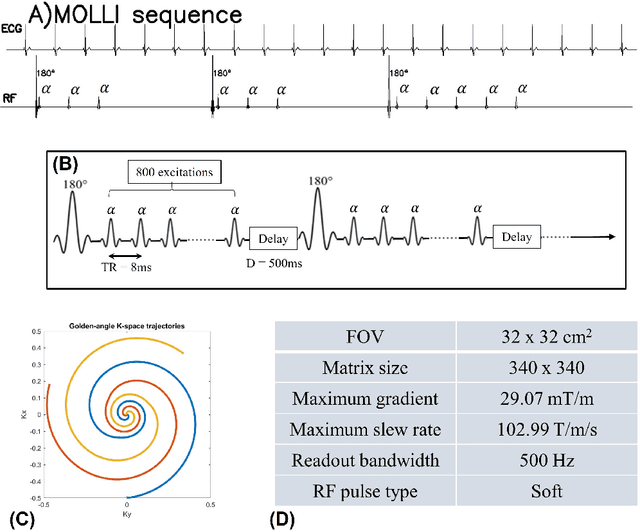
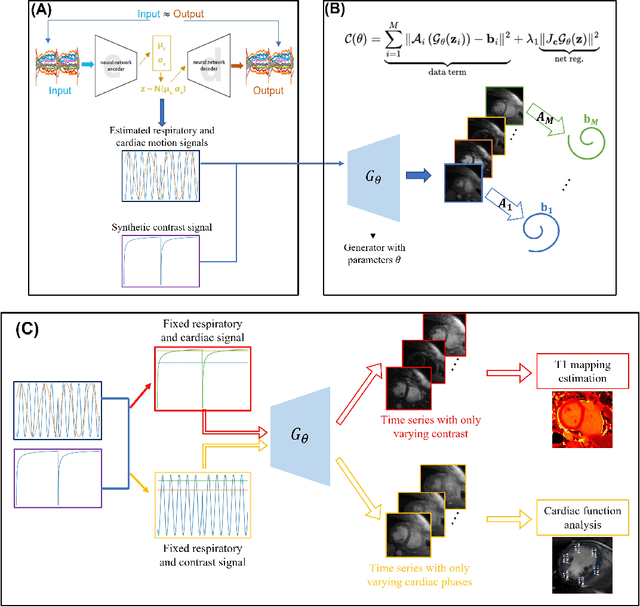
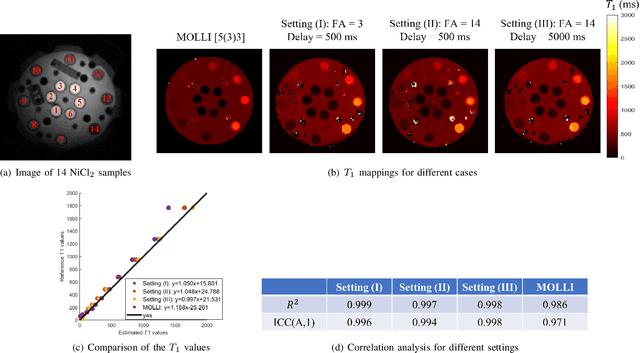
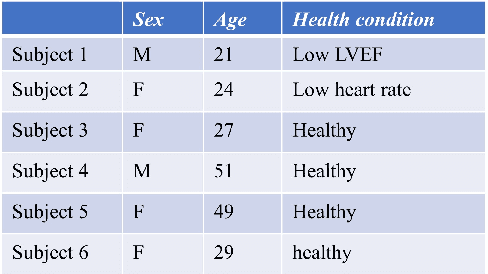
Abstract:In this work, we proposed a continuous-acquisition strategy using a gradient echo (GRE) inversion recovery sequence based on spiral trajectories to simultaneously obtain the $T_1$ mapping and CINE imaging. The acquisition is using a free-breathing and ungated fashion. An approach based on variational auto-encoder(VAE) is used for the motion estimation from the centered k-space data. The motion signal is then used to train a deep manifold reconstruction algorithm for image reconstruction. Once the network is trained, we can excite the latent vectors (the estimated motion signals and the contrast signal) in any way as we wanted to generate the image frames in the time series. We can estimate the $T_1$ mapping using the generated image frames where only contrast is varying. We can also generate the breath-hold CINE in different contrast.
Dynamic imaging using Motion-Compensated SmooThness Regularization on Manifolds (MoCo-SToRM)
Dec 06, 2021


Abstract:We introduce an unsupervised motion-compensated reconstruction scheme for high-resolution free-breathing pulmonary MRI. We model the image frames in the time series as the deformed version of the 3D template image volume. We assume the deformation maps to be points on a smooth manifold in high-dimensional space. Specifically, we model the deformation map at each time instant as the output of a CNN-based generator that has the same weight for all time-frames, driven by a low-dimensional latent vector. The time series of latent vectors account for the dynamics in the dataset, including respiratory motion and bulk motion. The template image volume, the parameters of the generator, and the latent vectors are learned directly from the k-t space data in an unsupervised fashion. Our experimental results show improved reconstructions compared to state-of-the-art methods, especially in the context of bulk motion during the scans.
Deep Image Prior using Stein's Unbiased Risk Estimator: SURE-DIP
Nov 21, 2021


Abstract:Deep learning algorithms that rely on extensive training data are revolutionizing image recovery from ill-posed measurements. Training data is scarce in many imaging applications, including ultra-high-resolution imaging. The deep image prior (DIP) algorithm was introduced for single-shot image recovery, completely eliminating the need for training data. A challenge with this scheme is the need for early stopping to minimize the overfitting of the CNN parameters to the noise in the measurements. We introduce a generalized Stein's unbiased risk estimate (GSURE) loss metric to minimize the overfitting. Our experiments show that the SURE-DIP approach minimizes the overfitting issues, thus offering significantly improved performance over classical DIP schemes. We also use the SURE-DIP approach with model-based unrolling architectures, which offers improved performance over direct inversion schemes.
Joint alignment and reconstruction of multislice dynamic MRI using variational manifold learning
Nov 21, 2021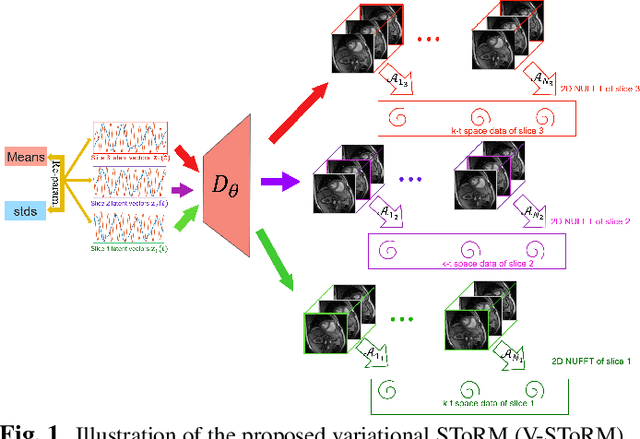
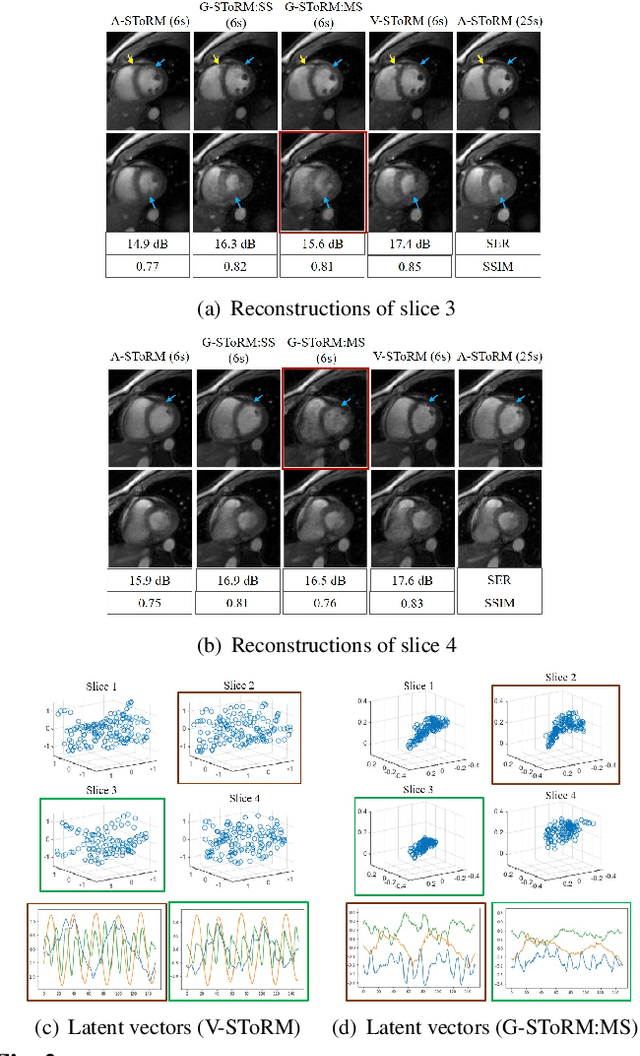

Abstract:Free-breathing cardiac MRI schemes are emerging as competitive alternatives to breath-held cine MRI protocols, enabling applicability to pediatric and other population groups that cannot hold their breath. Because the data from the slices are acquired sequentially, the cardiac/respiratory motion patterns may be different for each slice; current free-breathing approaches perform independent recovery of each slice. In addition to not being able to exploit the inter-slice redundancies, manual intervention or sophisticated post-processing methods are needed to align the images post-recovery for quantification. To overcome these challenges, we propose an unsupervised variational deep manifold learning scheme for the joint alignment and reconstruction of multislice dynamic MRI. The proposed scheme jointly learns the parameters of the deep network as well as the latent vectors for each slice, which capture the motion-induced dynamic variations, from the k-t space data of the specific subject. The variational framework minimizes the non-uniqueness in the representation, thus offering improved alignment and reconstructions.
Dynamic imaging using motion-compensated smoothness regularization on manifolds
Nov 21, 2021


Abstract:We introduce an unsupervised deep manifold learning algorithm for motion-compensated dynamic MRI. We assume that the motion fields in a free-breathing lung MRI dataset live on a manifold. The motion field at each time instant is modeled as the output of a deep generative model, driven by low-dimensional time-varying latent vectors that capture the temporal variability. The images at each time instant are modeled as the deformed version of an image template using the above motion fields. The template, the parameters of the deep generator, and the latent vectors are learned from the k-t space data in an unsupervised fashion. The manifold motion model serves as a regularizer, making the joint estimation of the motion fields and images from few radial spokes/frame well-posed. The utility of the algorithm is demonstrated in the context of motion-compensated high-resolution lung MRI.
Dynamic imaging using a deep generative SToRM model
Feb 11, 2021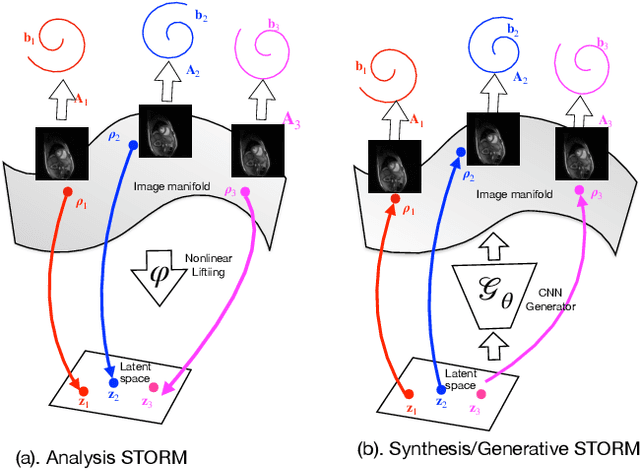
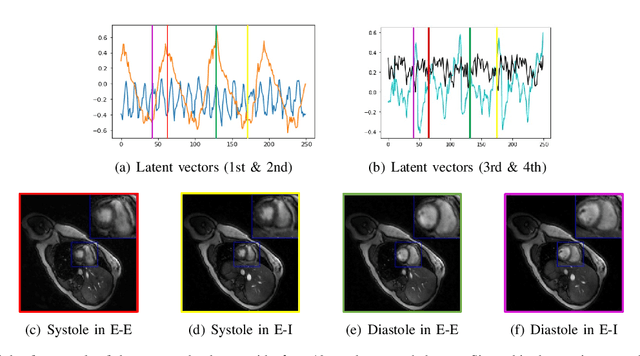
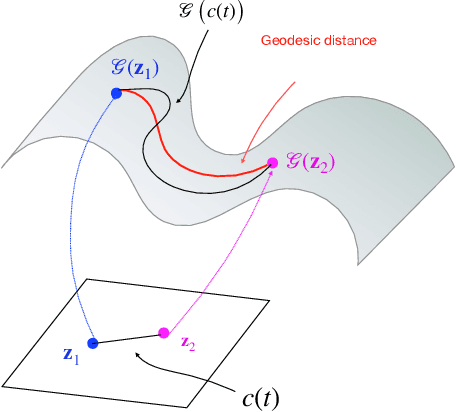
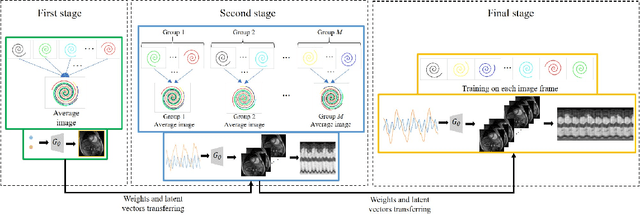
Abstract:We introduce a generative smoothness regularization on manifolds (SToRM) model for the recovery of dynamic image data from highly undersampled measurements. The model assumes that the images in the dataset are non-linear mappings of low-dimensional latent vectors. We use the deep convolutional neural network (CNN) to represent the non-linear transformation. The parameters of the generator as well as the low-dimensional latent vectors are jointly estimated only from the undersampled measurements. This approach is different from traditional CNN approaches that require extensive fully sampled training data. We penalize the norm of the gradients of the non-linear mapping to constrain the manifold to be smooth, while temporal gradients of the latent vectors are penalized to obtain a smoothly varying time-series. The proposed scheme brings in the spatial regularization provided by the convolutional network. The main benefit of the proposed scheme is the improvement in image quality and the orders-of-magnitude reduction in memory demand compared to traditional manifold models. To minimize the computational complexity of the algorithm, we introduce an efficient progressive training-in-time approach and an approximate cost function. These approaches speed up the image reconstructions and offers better reconstruction performance.
Deep Generative SToRM model for dynamic imaging
Jan 29, 2021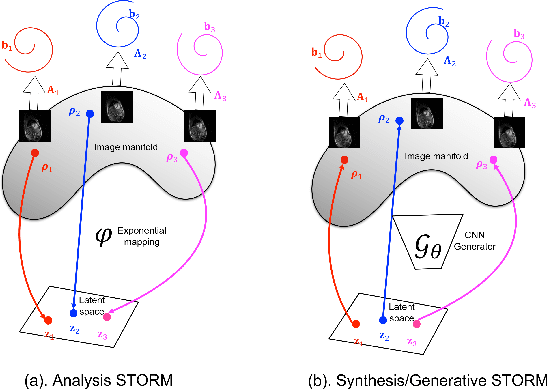
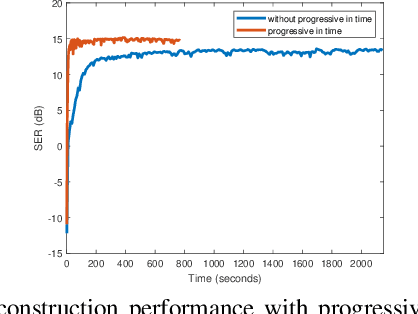
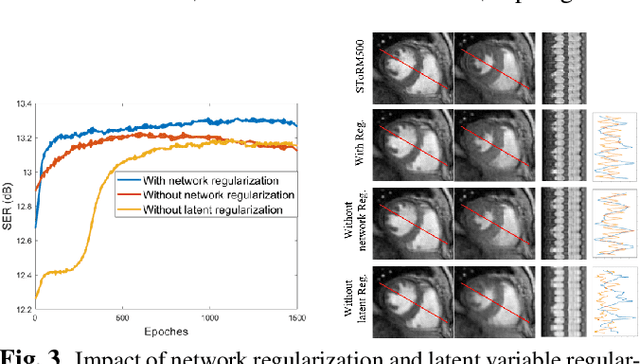
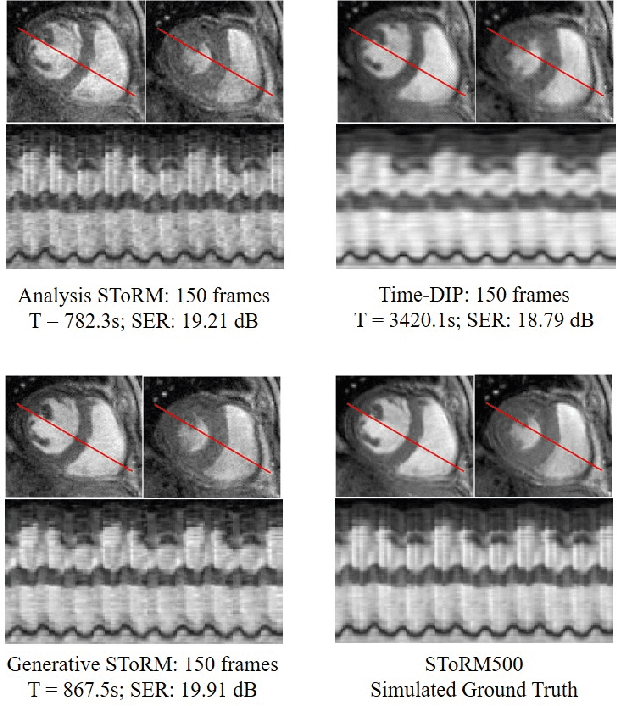
Abstract:We introduce a novel generative smoothness regularization on manifolds (SToRM) model for the recovery of dynamic image data from highly undersampled measurements. The proposed generative framework represents the image time series as a smooth non-linear function of low-dimensional latent vectors that capture the cardiac and respiratory phases. The non-linear function is represented using a deep convolutional neural network (CNN). Unlike the popular CNN approaches that require extensive fully-sampled training data that is not available in this setting, the parameters of the CNN generator as well as the latent vectors are jointly estimated from the undersampled measurements using stochastic gradient descent. We penalize the norm of the gradient of the generator to encourage the learning of a smooth surface/manifold, while temporal gradients of the latent vectors are penalized to encourage the time series to be smooth. The main benefits of the proposed scheme are (a) the quite significant reduction in memory demand compared to the analysis based SToRM model, and (b) the spatial regularization brought in by the CNN model. We also introduce efficient progressive approaches to minimize the computational complexity of the algorithm.
Alignment & joint recovery of multi-slice dynamic MRI using deep generative manifold model
Jan 20, 2021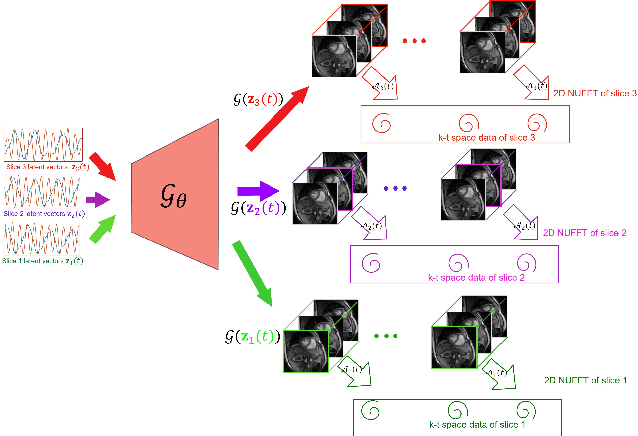
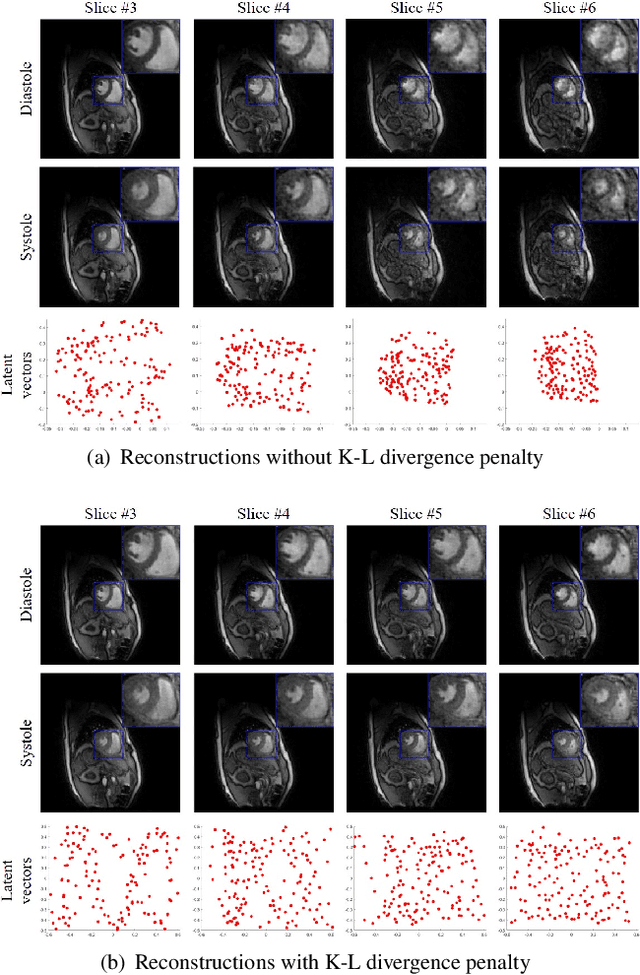
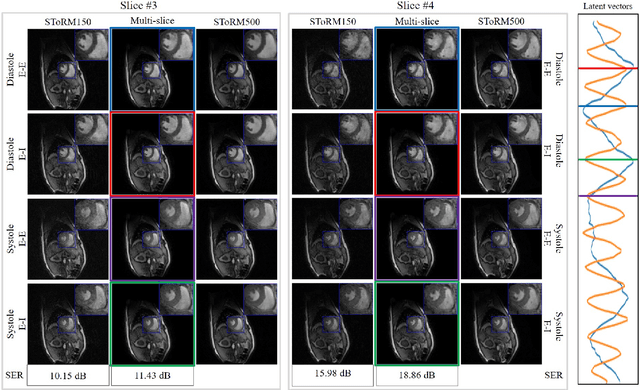
Abstract:We introduce a novel unsupervised deep generative manifold model for the recovery of multi-slice free-breathing and ungated cardiac MRI from highly undersampled measurements. The proposed scheme represents the multi-slice volume at each time point as the output of a deep convolutional neural network (CNN) generator, which is driven by latent vectors that capture the cardiac and respiratory phase at the specific time point. The main difference between the proposed method and the traditional CNN approaches is that the proposed scheme learns the network parameters from only the highly undersampled data rather than the extensive fully-sampled training data. We also learn the latent codes from the undersampled data using the stochastic gradient descent. Regularizations on the network and the latent codes are introduced to encourage the learning of smooth image manifold and the latent codes for each slice have the same distribution. The main benefits of the proposed scheme are (a) the ability to align multi-slice data and capitalize on the redundancy between the slices; (b) the ability to estimate the gating information directly from the k-t space data; and (c) the unsupervised learning strategy that eliminates the need for extensive training data.
 Add to Chrome
Add to Chrome Add to Firefox
Add to Firefox Add to Edge
Add to Edge